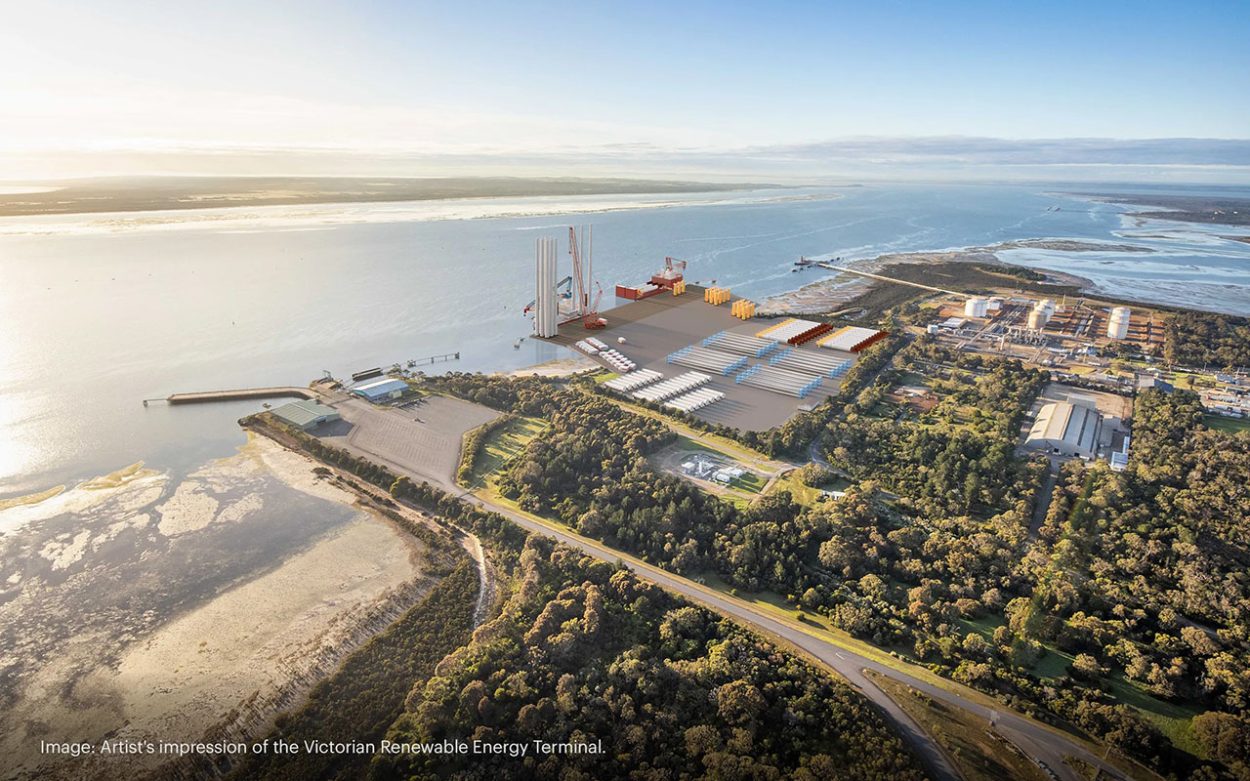The proposed Victorian Renewable Energy Terminal (VRET) in Western Port Bay is a step closer after the federal government deemed the project a “controlled action”.
The announcement, by federal Environment Minister Murray Watt on 31 July, progresses the project to a combined state and federal Environment Effects Statement (EES) assessment process and potential approval.
The VRET involves building a dedicated assembly port in Western Port Bay to support the construction of Victoria’s first offshore wind farms along the Victorian coast.
The decision comes after plans for the terminal were put on hold in January 2024, when the former federal Environment Minister, Tanya Plibersek, rejected the project on grounds that it would have “unacceptable and unmitigable risks to the ecological values of Western Port’s Ramsar Wetlands”, under Commonwealth environment protection laws (Federal veto a blow to terminal plans, The News 10/1/24).
Soon after the decision, the Port of Hastings Corporation (POHC) announced that on the advice of the Allen government, design work and environmental studies would continue in preparation for the EES assessment process, and a revised project design would form the basis of a new referral to the federal government under the Environment Protection and Biodiversity Conservation Act.
The proposed VRET is earmarked for a 25-hectare site on what is known as the Old Tyabb Reclamation Area, between Esso’s Long Island Point jetty and the BlueScope Steel wharves.
The POHC argues that this location “makes it an ideal location for an offshore wind assembly port, with large areas of appropriately zoned land close to deep water channels and proximity to proposed offshore wind farms off the Gippsland and Southern Ocean regional coasts.”
Minister Watt’s decision that the project is a “controlled action” has been welcomed by the POHC with them stating, “the Victorian Renewable Energy Terminal is an important enabling project for Victoria’s clean energy future, and this determination is an important step forward, confirming the project will continue through environmental assessment”.
According to the POHC, “The preliminary impact assessments, submitted as part of the EPBC Act referral found potential impacts from the project would be small, localised and temporary, with nothing indicating the impacts would be unacceptable”.
This position will be robustly examined as part of the EES assessment.
Also welcoming the news was the Committee for Frankston & Mornington Peninsula, with CEO Josh Sinclair telling The News, “The Committee has been a vocal supporter of this project since 2023, and we strongly believe it will have a positive impact on Hastings and Western Port communities.
“The Victorian Renewable Energy Terminal is an important enabling project for Victoria’s plans for offshore wind, and this determination confirms the project will continue through environmental assessment.”
While welcoming the federal decision for a “controlled action”, several environmental groups continue to raise concerns about the project and its placement within Western Port’s internationally accredited wetlands.
Among those groups is Save Westernport, whose spokesperson, Julia Stockigt told The News, “We fully support the need to urgently move to renewables at speed, but we are yet to be presented with a convincing rationale for locating a project of this scale, with its potential to cause irreparable damage in Western Port Bay over decades in operation, when other potentially suitable locations exist.”
“We question whether the current, revised plan differs enough from the initial design that Minister Plibersek rejected in her 2024 ruling, when she found it would have clearly unacceptable impacts on the ecological character and the habitat of threatened species and communities in Western Port’s Ramsar wetlands.
“The Victorian government has not released the selection criteria report used to rule out other potentially suitable sites and choose the Port of Hastings, within a protected Ramsar wetland of international significance, as their ‘preferred location’ for the Victorian Renewable Energy Terminal.”
The “controlled action” designation will result in an environmental assessment constrained to looking at the Western Port Bay site for the VRET, without considering other options.
“While the POHC, as the proponent, has reduced the project footprint and the extent of dredging in the revised design, we note that a number of unmanageable impacts still remain,” said Stockigt.
“Not least of these would be the enormous increase in shipping traffic in Western Port. The prolonged impacts of sediment mobilisation could devastate Western Port’s intertidal wetlands and marine ecosystems over the decades of this project’s operation. We question whether this complies with the Wise Use of Wetlands— an obligation conferred by Western Port’s Ramsar status.”
Shannon Hurley, marine campaigner for The Victorian National Parks Association (VNPA) has been another voice of concern.
“We want certainty that the project can be done in a way that doesn’t cause unacceptable harm to the Western Port wetlands and we aren’t confident that has been achieved yet.”
The EES assessment process will provide all parties with the opportunity to thoroughly examine the project and its potential adverse environmental outcomes.
Save Westernport, VNPA, Western Port Peninsula Protection Council, the Western Port Biosphere, and French Island Citizens Association are among the participating members of the port’s community reference group. The CRG will continue to meet throughout the EES assessment process.
The VRET project is required to obtain approval from both State and Federal governments before construction can commence.
First published in the Mornington News – 12 August 2025



